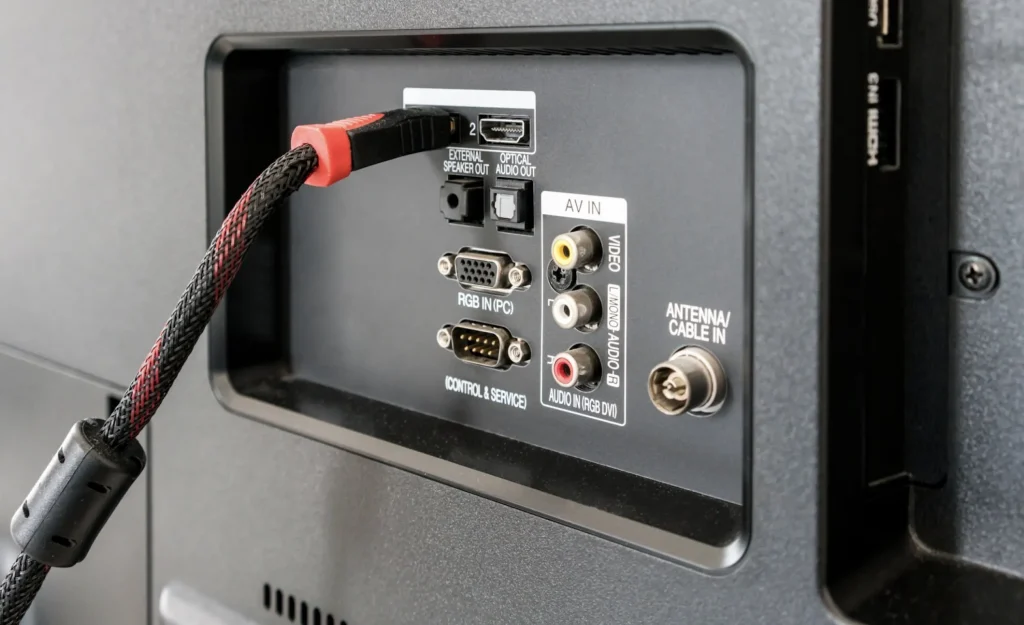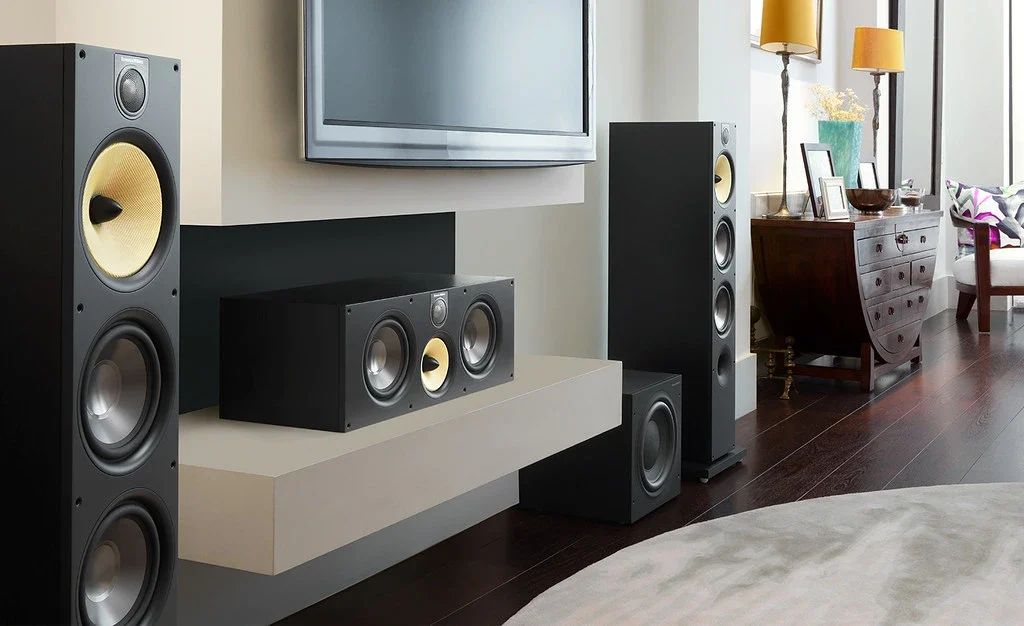I’m confident that you’ve seen an outstanding film or heard some affecting music, yet didn’t quite relish it. It’s possible, despite superior picture quality, you missed the ambiance of a movie theater. Clearly, the absence of sparkle isn’t due to the streaming devices you use, but rather, it’s your speaker system that’s in question.
So, do you desire to build a high-quality home theater setup that will give you a surreal experience of the surround sound system? Well, that’s what we wish to help you with. We will take you on a step-by-step procedure on how to build a top-rated home theater system.
What You Will Need
Building a home theater is not just about having the latest and biggest 4k tv, rear speakers, and front speakers. It entails careful contemplation of the space you have at hand, the media sources, the desired specs, your working budget, and what is your main use for the system.
You will thus need to find the following accessories to ensure you have the best setup.
1. TV and Projector

The central piece of a home theater is often the TV. When you get into most houses, you find that all other furniture is pointed towards it. You must be keen not to make a mistake. Make calculated considerations regarding the size of the tv. This ensures you don’t have a very small one that people have to squint or a very big one that is crowding everything else.
Also, choose the display technology and resolution carefully. You will ultimately have better picture quality if you have a higher resolution. 4K TV OLED is undisputedly the phenomenal king of TVs. You can thus look for an LG, Sony, TCL, among many others you can choose from.
However, some people prefer to have a projector in a darkened room instead of a TV. Only be sure to get a 4K home theater projector to get the best picture quality.
2. Sound systems

Most of the TVs focus on giving you the best realistic visual pictures and fail on the sound part. You need, therefore, to invest in alternative sound speakers and subwoofer. The sound system is the backbone of the home theater. This sound system must be built in a similar way to the multi-channel speaker setup found in theater cinemas.
It would be best if you had rear channel speakers, center channel speakers, front speakers, and surround sound systems. On top of that, you will need a subwoofer to give your sound weight. If you are looking for an immersion kind of sound, you will also need the above speakers.
You can choose to build your sound from various combinations of different hardware pieces to achieve a multiplex sound. Alternatively, you can purchase ready-to-use sound systems. You can buy the best soundbars and add a subwoofer and surround speakers.
3. Home theater AV receiver
The receiver can be described as the brain or central nervous system of the home theater. It is the power source for all the speakers since they are all connected to it. When purchasing a receiver, it is important to find one with a bandwidth power of between 20Hz to 20KHz. It is also important to consider the RMS power rating so that it offers good sound for long periods.
Another important factor to consider is the number of channels you require. You may wish to find a receiver with a good number of channels if you desire surround sound. That means you may need to invest in a 5.1, 7.1 or even a 9.1 channel receiver. One channel translates into one speaker.
Also, pay close attention to the number of inputs. Overall, it is better to have more inputs and channels since they give you room for future expansion.
4. Media source
You now have a TV screen and amazing sound, but you still need to have something to play your music and movies. You will need to watch your movies in the best quality possible, meaning 4K ultra-HD.
To get this quality, you will need to acquire a 4k Blu-ray player. You could get one from Panasonic but ensure it offers Dolby Atmos Vision and is over a 7.1 channel. Also, ensure that it offers streaming services, and you will have a wondrous viewing experience.
Alternatively, you can get a gaming console such as the Xbox or PS since they have awesome media features and a Blu-ray drive.
Steps of Building a Home Theater System
Now that you know what you should have, let’s delve in how to set it all up.
Step 1# Getting the Best Location
You will need to find a suitable location for setting up a great sound without disturbing other people. A home theater’s ideal dimensions range around 13 ft wide by 20 ft long. It could be better if it is a bit separated from the home or isolated. You will also need the space to set up the entire system without overcrowding the room and making the sound obnoxious.
Great options could be
- Make a theater room off the living room.
- Use an unused bedroom that has the right dimensions.
Step 2# Connecting the AV Receiver
Here, you will need to do several things, since everything is connected to your receiver. First, you will need to connect all your inputs to the AV receiver. It is crucial to have a receiver that has a good number of inputs and HDMI ports. You get to connect a PlayStation, a TV, a Blu-ray player and a cable box. It could also leave one port for future use.

Second, connect the speakers to the output ports on the receiver. At the back of the receiver, you will see the output ports that connect to the speakers. Be careful to note the positive speaker terminals, which are red, must be connected to the positive ones on the speakers. Similarly, the negative ones must be connected well.
Step 3# Setting Up the Main Speakers
Main speakers are vital and need to be high-quality and heavyweight. You will need the best sound from them, thus ensuring you get the best ones you can find.
To get the best sound and aesthetics, you need floor-standing large-sized speakers. These will not only give you a crystalline sound but also looks pretty. You set this to the front of the room on either side of the TV; the left and right front.
If you cannot fit in floor-standing speakers, you could go with powerful bookshelf speakers. All this depends on your budget and the space you have in your room, but floor-standing speakers at the front will look outstanding. You can choose from a wide range of speakers, such as the Klipsch RP-8000F.
We also have fantastic bookshelf models such as Klipsch RP-600, which are very adept at giving a distinct and natural sound. Bookshelf models are actually perfect for rear speakers.
Step 4# Setting Up Center Channels
Who wants a movie that they can’t understand anything because they can’t hear a thing of what is spoken? Hearing clear dialogues is the central thing in watching movies. To clearly hear dialogues, you will need to set up the center channels carefully.
The centerpieces are critical in the production of crisp, clear, and audible dialogue. Set them centrally at the top or bottom of your screen. Doing this gives the effect that the sound is coming from the center of the screen.
If you desire optimum performance from center speakers, place them on an angle that faces the seating position. Also, ensure the tweeter is at head level thus, if the speaker is higher or lower, you will need to tilt it a bit. Ensure that they are set at head level without any obstruction.
If you desire to have such an explosive centerpiece audio sound, consider looking for great centerpieces such as the Klipsch RP-504C.
Step 5# Setting Up Rear Channel Speakers
Rear channel speakers also play a vital role in giving you a rich and distinct immersive sound. You feel like you are in the movie itself as if bullets are whizzing past you. You are totally immersed in the movie.
You should place these speakers at the back of the seating position. Ensure they are at the very back of the room and should be a bit closer and higher than the front ones. Doing this creates a good envelope of the sound between the front and the rear speakers.
For this, you will need full standing speakers at your back. You will also need side surrounds and elevation speakers.
Step 6# The Subwoofers

The subwoofer gives you the distinct big booming sound. It enriches the bass sound by producing the lower frequencies of the music or movie. Do you desire to feel the sound of the rumbles and the dynamic explosions? Get a good subwoofer.
In a movie theater, you would probably feel your chair shake a little because of the power of the subwoofers. Depending on the speakers you already have, a great subwoofer will be the ultimate booster.
The best placement for your subwoofer is as part of the central sound system. Doing this considerably increases the depth and width of the soundstage. The sound is able to bounce around the entire room. You could also place it on a corner or near a wall at the front. You can also add a second subwoofer at the back if you desire, this ensures the bass fill all the space and balances out.
Of course, you must also take into consideration the room’s layout and the arrangement of furniture. Try different positions taking into account the room’s natural acoustics and any barriers in the room until you get the perfect setup.
Parting shot
A home theater system can oftentimes be intimidating because of all the various products, pieces, and technical details that go into setting it up. However, that is not a reason to lose all the joys and robust experience you get as you tune in to the next blockbuster movie or your favorite show.
So, why don’t you go right ahead and implement the simple steps above now that you know how to build a home theater system.

![How to Build a Home Theater System [Your 6-Step Guide]](https://omghowto.com/wp-content/uploads/thumbs_dir/Sonos-Beam-Vs.-Bose-Soundbar-300-1-ptsfw1zn6noil5a03re6kkyrvk9e0ha7z4pwxhqr0c.jpg)
![How to Build a Home Theater System [Your 6-Step Guide]](https://omghowto.com/wp-content/uploads/thumbs_dir/Best-Soundbar-For-Sony-TV-qjoy6sww075zn6xrctq0322u9215gukwuykovx5mws.webp)



